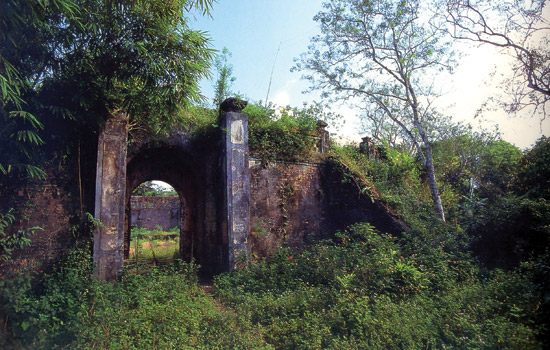(No.4, Vol.2 Apr 2012 Vietnam Heritage Magazine)
Hổ Quyá»n (hổ, here, means tiger and quyá»n boxing) arena, four kilometres southwest of Hue, was for elephant and tiger fights to entertain Emperor and staff. According to letters carved on the gate, the arena was built in the 1830s, during the reign of Minh Mang.
The arena was also used for the training of military elephants.
Trader Pierre Poivre said, ‘In 1750, the Lord of the Nguyen, Phuc Khoat, and his servants went to Da Vien Island, near the arena, on 12 boats to witness the fights between the tigers and elephants.’ In that combat, 40 elephants killed 18 tigers.
During the reign of Gia Long (1802-1919), all elephant-and-tiger fights were on an empty piece of land in front of the Citadel. As there was no surrounding wall, the King commanded his soldiers to stand in a circle.
In a memoir, Souvenirs de Hue [Hue Memories] (published by Typhon in Shanghai, China, 1941) Michel Duc Chaingeau, a Frenchman who had witnessed the fights wrote, ‘In a fight one day, although the tiger was tied alone to a reliable pole and its nails and fangs chopped off, it managed to rip the rope off and quickly jumped on to the elephant-driver. The driver was extremely frightened and in no time was thrown to the ground and sadly crushed by his own elephant. Then, with all his anger, the tiger jumped among the soldiers and a lot of them were heavily injured. King Gia Long and his staff were completely terrified.’
Buu Ke wrote in Nguyá»…n Triá»u Cố Sá»± [Nguyen Dynasty Stories]: ‘In 1829, the Nguyen Government held a combat between tigers and elephants on the north bank of Huong River. His Majesty sat on a dragon boat anchored not far off to watch. The tiger was tied on to a rope and the other end of the rope was tied to a strong pole. However, during his match with an elephant, the tiger pulled off the rope and jumped into the water, swimming towards the Emperor’s boat. . . . Emperor Minh Mang quickly took a stick (used to push the boat) to scare the tiger off. Then he commanded his soldiers to use a small boat to approach and kill the tiger in the water.
Hổ Quyá»n, now in Nguyet Kieu Village, Thuy Bieu Ward, Hue City, was built in the Year of the Tiger 1930 during the rule of Minh Mang. The fights were held according to no schedule. Some years there were several, some years none.

From the book Hue Cite Imperiale du Vietnam, Edition Abbeville, 1995.
According to Phan Thuan An, author of ‘Quần Thể Di TÃch Huế, 2007,’ [Hue Relics, 2007] the last match at Hổ Quyá»n occurred in 1904 during the reign of Thanh Thai. On the day of the match, a female elephant fearlessly walked into the arena, wandering before a tiger. Having observed the elephant’s attitude, Thanh Thai offered the compliment ‘What a brave thing!’ As the Emperor finished his words, the tiger jumped on to the elephant’s forehead. The elephant shook her head strongly, throwing the tiger to the ground. The tiger made another jump and got on to the elephant in the same place. The elephant roared and ran to the wall of the arena and with all her might pushed the tiger against the wall. The angry tiger was one more time thrown down to the ground, this time crushed.
Hổ Quyá»n was more or less abandoned after that and has remained so. One of the reasons was that economical difficulty stopped the budget for hunting tigers and elephants for the fights. Another reason was that tension between Emperor Thanh Thai and the colonial government had become more serious and so there was no longer the mood for the fights.
The architecture of Hổ Quyá»n arena is simple and strong. The materials are brick, stone and cement. The arena is still in good condition after 182 years.
The arena has no roof and is circular. The circumference is 140 m and diameter 44 m. There is special place for the King. There are five cages where the tigers were kept before the matches. The field is round and planted with grass.
According to thinking during the Nguyen Dynasty, the elephant was royal, strong and useful, whereas the tiger was a threat to people. At the fights, the elephants always had to win and kill the tigers. Before a match, the tigers had their fangs and claws removed. A match went until the tigers were dead.
* Nguyen Dac Xuan is a researcher specialising in Hue

From a photographic postcard showing elephants heading for the arena to fight; the arena recently, after the removal of vegetation that partially covered it; a view from on the wall of the arena the same day; elephants in the arena and being prepared to fight. Recent photos (2011): Thai A; old photos: from postcards collected in France in 1996 by Nguyen Dac Xuan



